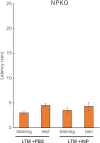Neuropsin-dependent and -independent behavioral tagging
- PMID: 33773089
- PMCID: PMC8340819
- DOI: 10.1002/npr2.12177
Neuropsin-dependent and -independent behavioral tagging
Abstract
Aim: The consolidation of short-term memories into long-term memories is promoted by associations with novel environmental stimuli. This phenomenon is known as behavioral tagging. Neuropsin, a plasticity-related serine protease in the hippocampus and amygdala, is involved in memory formation. This study investigated how neuropsin affects associative long-term memory.
Methods: Short-term and long-term memory were assessed in control and neuropsin-deficient mice by investigating their performance in inhibitory avoidance and spatial object recognition tasks. The effect of exposure to novelty on the conversion of short-term memory to associative long-term memory was also examined.
Results: The consolidation of task-related short-term memories into long-term memories was facilitated by exposing the animals to a novel environment 1 hour before training. However, this long-term memory conversion was impaired in neuropsin-deficient mice performing the inhibitory avoidance task but not the spatial object recognition task.
Conclusion: Behavioral tagging occurs via neuropsin-dependent and neuropsin-independent processes for different behavioral tasks.
Keywords: LTM; STM; behavioral tagging; neuropsin.
© 2021 The Authors. Neuropsychopharmacology Reports published by John Wiley & Sons Australia, Ltd on behalf of the Japanese Society of Neuropsychopharmacology.
Conflict of interest statement
The authors declare no conflicts of interest associated with this manuscript. The authors have no conflicts of interest directly relevant to the content of this article.
Figures







Similar articles
-
PKM-ζ Expression Is Important in Consolidation of Memory in Prelimbic Cortex Formed by the Process of Behavioral Tagging.Neuroscience. 2019 Jul 1;410:305-315. doi: 10.1016/j.neuroscience.2019.03.060. Epub 2019 Apr 24. Neuroscience. 2019. PMID: 31026567
-
Environment Enrichment Facilitates Long-Term Memory Consolidation through Behavioral Tagging.eNeuro. 2023 Apr 14;10(4):ENEURO.0365-22.2023. doi: 10.1523/ENEURO.0365-22.2023. Print 2023 Apr. eNeuro. 2023. PMID: 36941060 Free PMC article.
-
Protein Kinase C-Gamma Knockout Mice Show Impaired Hippocampal Short-Term Memory While Preserved Long-Term Memory.Mol Neurobiol. 2021 Feb;58(2):617-630. doi: 10.1007/s12035-020-02135-6. Epub 2020 Sep 30. Mol Neurobiol. 2021. PMID: 32996086
-
Behavioral tagging: A novel model for studying long-term memory.Neurosci Biobehav Rev. 2016 Sep;68:361-369. doi: 10.1016/j.neubiorev.2016.05.017. Epub 2016 May 20. Neurosci Biobehav Rev. 2016. PMID: 27216211 Review.
-
The integrated role of ACh, ERK and mTOR in the mechanisms of hippocampal inhibitory avoidance memory.Neurobiol Learn Mem. 2015 Mar;119:18-33. doi: 10.1016/j.nlm.2014.12.014. Epub 2015 Jan 13. Neurobiol Learn Mem. 2015. PMID: 25595880 Review.
Cited by
-
Silibinin's role in counteracting neuronal apoptosis and synaptic dysfunction in Alzheimer's disease models.Apoptosis. 2025 Apr;30(3-4):861-879. doi: 10.1007/s10495-024-02073-x. Epub 2025 Jan 20. Apoptosis. 2025. PMID: 39833635
References
-
- Frey U, Morris RG. Synaptic tagging and long‐term potentiation. Nature. 1997;385:533–6. - PubMed
Publication types
MeSH terms
LinkOut - more resources
Full Text Sources
Other Literature Sources

